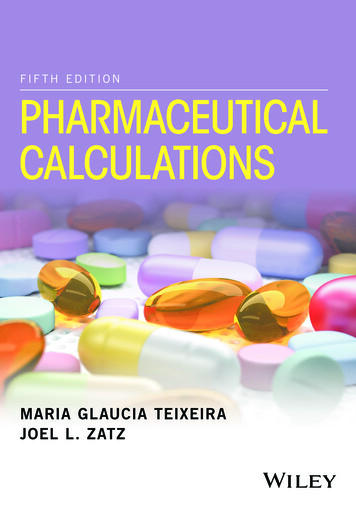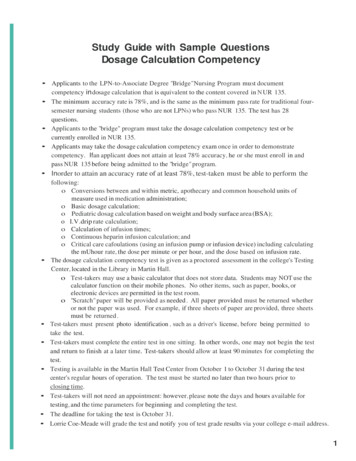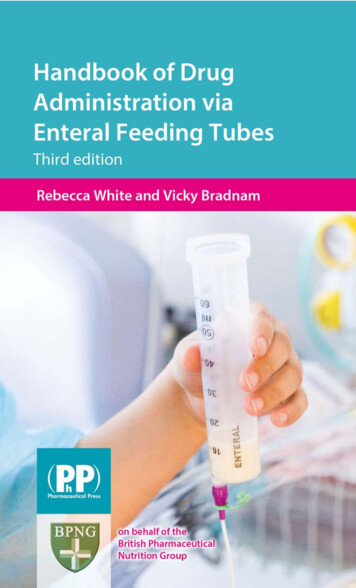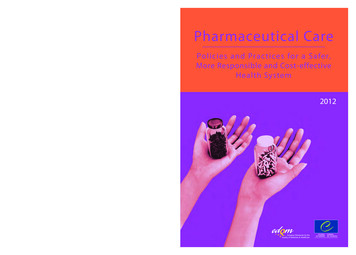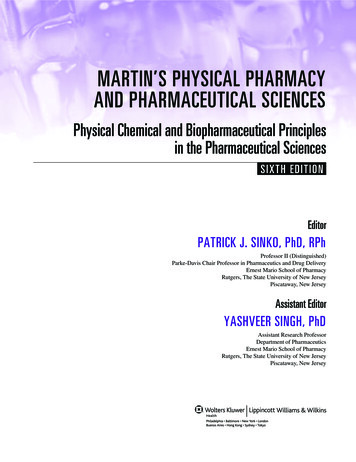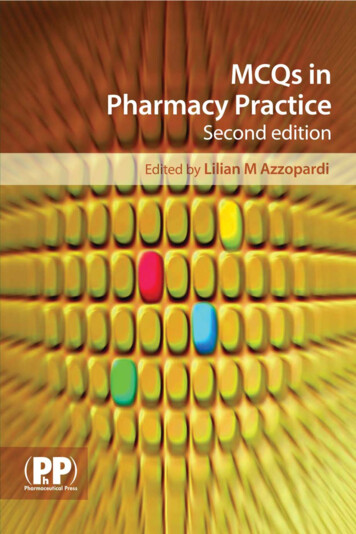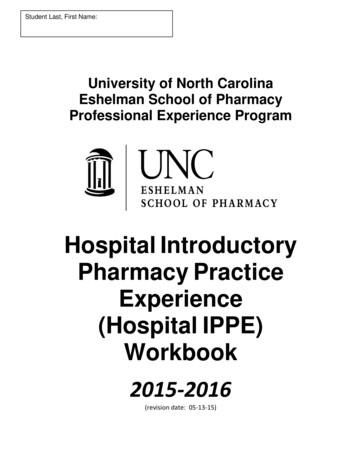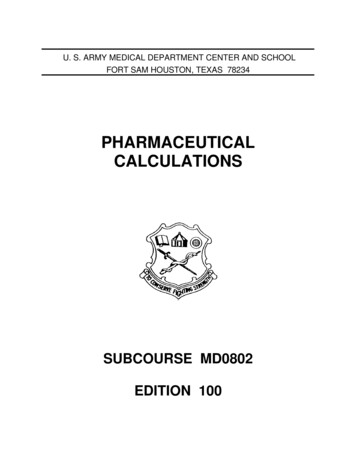
Transcription
U. S. ARMY MEDICAL DEPARTMENT CENTER AND SCHOOLFORT SAM HOUSTON, TEXAS 78234PHARMACEUTICALCALCULATIONSSUBCOURSE MD0802EDITION 100
DEVELOPMENTThis subcourse is approved for resident and correspondence course instruction. Itreflects the current thought of the Academy of Health Sciences and conforms to printedDepartment of the Army doctrine as closely as currently possible. Development andprogress render such doctrine continuously subject to change.The instructional systems specialist for the revision of this version of the subcourse was:Mr. John Arreguin; AMEDDC&S, ATTN: MCCS-HCP, 3151 Scott Road, Fort SamHouston, TX 78234; DSN 471-8958; john.arreguin@amedd.army.mil.The subject matter expert responsible for the revision of this version of the subcoursewas: MSG Karen K. Reynolds, MCCS-HCP, Pharmacy Branch, Department of ClinicalSupport Services.ADMINISTRATIONStudents who desire credit hours for this correspondence subcourse must meeteligibility requirements and must enroll through the Nonresident Instruction Branch ofthe U.S. Army Medical Department Center and School (AMEDDC&S).Application for enrollment should be made at the Internet website:http://www.atrrs.army.mil. You can access the course catalog in the upper right corner.Enter School Code 555 for medical correspondence courses. Copy down the coursenumber and title. To apply for enrollment, return to the main ATRRS screen and scrolldown the right side for ATRRS Channels. Click on SELF DEVELOPMENT to open theapplication and then follow the on screen instructions.In general, eligible personnel include enlisted personnel of all components of the U.S.Army who hold an AMEDD MOS or MOS 18D. Officer personnel, members of otherbranches of the Armed Forces, and civilian employees will be considered eligible basedupon their AOC, NEC, AFSC or Job Series which will verify job relevance. Applicantswho wish to be considered for a waiver should submit justification to the NonresidentInstruction Branch at e-mail address: accp@amedd.army.mil.For comments or questions regarding enrollment, student records, or shipments,contact the Nonresident Instruction Branch at DSN 471-5877, commercial (210) 2215877, toll-free 1-800-344-2380; fax: 210-221-4012 or DSN 471-4012, e-mailaccp@amedd.army.mil, or write to:NONRESIDENT INSTRUCTION BRANCHAMEDDC&SATTN: MCCS-HSN2105 11TH STREET SUITE 4191FORT SAM HOUSTON TX 78234-5064
TABLE OF CONTENTSParagraphs PageLessonINTRODUCTION1iiPHARMACEUTICAL CALCULATIONS ISection I. Review of Basic MathematicsSection II. Temperature ConversionsSection III. Prescription Interpretation.Section IV. Ratio and ProportionSection V. The Metric SystemSection VI. Common Systems of MeasureSection VII. Reduction and Enlargement of 351-451-581-661-73PHARMACEUTICAL CALCULATIONS IISection I. Specific GravitySection II. Percentage PreparationsSection III. Dilution of Stock PreparationsSection IV. ses32-22-122-232-312-42PHARMACEUTICAL CALCULATIONS IIIExercises3-1--3-53-23-10LIST OF TABLESTable2-13-1PageSpecific gravity of liquids at 25ºCThe nomogram.MD08022-93-7i
CORRESPONDENCE COURSE OFTHE U.S. ARMY MEDICAL DEPARTMENT CENTER AND SCHOOLSUBCOURSE MD0802PHARMACEUTICAL CALCULATIONSINTRODUCTIONOne of the most important areas of study for the pharmacy specialist ispharmaceutical calculations. A person might know a great deal about pharmacology,but if he cannot perform a pharmaceutical calculation, that knowledge cannot be appliedin a practical way. To prepare and dispense medications, you must be capable ofperforming a variety of pharmaceutical calculations. You must be constantly aware ofone fact-an error made in a dosage calculation can harm a patient. The study of thissubcourse will help give you the knowledge and skill required to perform many types ofdosage calculations.This subcourse is designed to focus on the systems of weights and measurescommonly used in the pharmacy. Examples in the text include drugs actually dispensedin outpatient pharmacy settings.Learning pharmaceutical calculations is like building a house; one part isdependent on the other and a good firm foundation supports it all. Memorizing theformulas and equivalents, developing a well-rounded knowledge of basic mathematics,and practicing what you are learning (that is, solving practice problems) will help yousuccessfully complete this subcourse. Although not required, it is advisable for you tohave completed Subcourse MD0801, Prescription Interpretation, before attempting thissubcourse.As you study this subcourse you will notice that practice problems are provided atthe end of each section. It is important that you solve these practice problems beforeyou go to the next section. Furthermore, you should complete each practice problembefore you attempt to take the final examination.Subcourse Components:This Subcourse consists of 3 lessons and an examination. The lessons are:Lesson 1. Pharmaceutical Calculations I.Lesson 2. Pharmaceutical Calculations II.Lesson 3. Pharmaceutical Calculations III.MD0802ii
Credit Awarded:Upon successful completion of this subcourse, you will be awarded 10 credithours.Materials Furnished:Materials provided include this booklet, an examination answer sheet, and anenvelope. Answer sheets are not provided for individual lessons in this subcoursebecause you are to grade your own lessons. Exercises and solutions for all lessons arecontained in this booklet. You must furnish a #2 pencil.Procedures for Subcourse Completion:You are encouraged to complete the subcourse lesson by lesson. When youhave completed all of the lessons to your satisfaction, fill out the examination answersheet and mail it to the U.S. Army Medical Department Center and School along withthe Student Comment Sheet in the envelope provided. Be sure that your social securitynumber is on all correspondence sent to the U.S. Army Medical Department Center andSchool. You will be notified by return mail of the examination results. Your grades onthe exam will be your rating for the subcourse.Study Suggestions:Here are some suggestions that may be helpful to you in completing thissubcourse.Read and study each lesson carefully.Complete the subcourse lesson by lesson. After completing each lesson,work the exercises at the end of the lesson, marking your answers in thisbooklet.After completing each set of lesson exercises, compare your answers withthose on the solutions sheet which follows the exercises. If you haveanswered an exercise incorrectly, check the reference cited after the answeron the solution sheet to determine why your response was not the correctone.As you successfully complete each lesson, go on to the next. When youhave completed all of the lessons, complete the examination. Mark youranswers in this booklet; then transfer your responses to the examinationanswer sheet using a #2 pencil.MD0802iii
Student Comment Sheet:Be sure to provide us with your suggestions and criticisms by filling out theStudent Comment Sheet (found at the back of this booklet) and returning it to us withyour examination answer sheet. Please review this comment sheet before studying thissubcourse. In this way, you will help us to improve the quality of this subcourse.MD0802iv
LESSON ASSIGNMENTLESSON 1Pharmaceutical Calculations I.TEXT ASSIGNMENTParagraphs 1-1 through 1-44.LESSON OBJECTIVESAfter completing this lesson, you should be able to:1-1. Perform addition, subtraction, multiplication,and division of whole numbers, fractions, anddecimals with 100 percent accuracy.1-2. Convert from degrees Centigrade to degreesFahrenheit and vice versa.1-3. Convert between the various denominations ofeach of the basic units of the metric system.1-4. List the conversion factors for the commonsystems which are most frequently used in thepharmacy.1-5. Reduce or enlarge pharmaceutical formulas asrequired in the pharmacy.1-6. Solve pharmaceutical problems using ratio andproportion and conversion factors.1-7. Perform pharmaceutical calculations using themetric system.SUGGESTIONMD0802After studying the assignment, complete theexercises at the end of this lesson. These exerciseswill help you to achieve the lesson objectives.1-1
LESSON 1PHARMACEUTICAL CALCULATIONS ISection I. REVIEW OF BASIC MATHEMATICS1-1. INTRODUCTIONa. Basic arithmetic is always involved in some manner in the solving ofpharmaceutical calculations. Perfecting basic mathematical functions will help to attainthe goal of 100 percent accuracy desired in pharmacy. Because of the need for 100percent accuracy, no partial credit will be given for setting a problem up correctly if theanswer is incorrect. In pharmacy, the correct answer is more important than themethod.b. Even if the operations performed in this lesson seem overly simple, do themfor practice/review. Most of the mistakes made by students taking this subcourse aremistakes in basic mathematics.1-2. FRACTIONSSome drugs have dosages expressed in fractions of a grain. Some calculationswill involve fractions, and it is important for you to have the ability to perform allmathematical procedures with fractions, whole numbers, and decimals.a. A fraction consists of two parts: the number above the line is called theNUMERATOR and the number below the line is called the DENOMINATOR.Example: In the fraction “1/2,” 1 is the NUMERATOR and 2 is theDENOMINATOR.1 NUMERATOR2 DENOMINATORb.Fill in the blanks:(1)What is the numerator in 3/4?The numerator in 3/4 is 3.(2)What is the numerator in 9/2?The numerator in 9/2 is 9.MD08021-2
(3)What is the denominator in 7/8?The denominator in 7/8 is 8.(4)What is the denominator in 12/5?The denominator in 12/5 is 5.1-3. COMMON DENOMINATORSa. When fractions have the same number in the denominator, they are said tohave COMMON DENOMINATORS. For example: 1/8, 2/8, 5/8, 7/8, and 3/8 all have aCOMMON DENOMINATOR of 8.b. Sometimes there is a need in mathematics to find a common denominator.For example, before fractions may be added or subtracted, the denominators of all thefractions in the problem must be the same.c.The following rules must be applied when working with fractions:(1)If the numerator and the denominator of a fraction are multiplied by thesame number, the value will not change.For example: Multiply the numerator and denominator of 1/2 by 2.2x2 41x2 22x24 then: 4 x 2 8 , and so forth.In this example: 1/2, 2/4, and 4/8 all have the same value.(2)If the numerator and the denominator of a fraction are divided by thesame number, the value of the fraction will not change.For example:4 2 22 2 18 2 4 then: 4 2 2 , and so forth.Again: 4/8, 2/4, and 1/2 all have the same value.d.To find a COMMON DENOMINATOR for the fractions 1/4, 3/8, and 5/16:(1)Find the largest denominator.(The largest denominator is 16.)MD08021-3
(2)See if the other denominators can be divided into 16 an even numberof times.(4 and 8 can both be divided into 16 an even number of times.)(3)the fraction.Change 1/4 to have a denominator of 16 without changing the value of(a) Multiply the denominator by 4 to make it 16:14 x 4 16(b) To avoid changing the value, multiply the numerator by 4:1 x 4 44 x 4 16(4)Change 3/8 to have the common denominator of 16.(a) Multiply the denominator 8 by 2 to make it 16.3 8 x 2 16(b) Because the value of the fraction is to remain the same, multiplythe numerator by 2.3 x 2 68 x 2 16(5)Therefore, the fractions 1/4, 3/8, and 5/16, when changed to have acommon denominator, will be 4/16, 6/16, and 5/16, respectively.e. When the denominators cannot be divided by the same number, find thesmallest denominator into which each of the original denominators will divide evenly. Inmany cases, a common denominator can be found by multiplying one denominator bythe other.For example: Find the common denominator for 3/4 and 2/3.(1)Multiply denominators to get a common denominator.4 x 3 12 (Common denominator)MD08021-4
(2)Change the fraction 3/4 to have a denominator of 12.(a) Multiply the denominator by 3 to make it 12:3 4 x 3 12(b) To avoid changing the value, multiply the numerator by 3:3 x 3 94 x 3 12(3)Change the fraction 2/3 to have a denominator of 12:(a) Multiply the denominator by 4 to make it 12:2 3 x 4 12(b) To avoid changing the value, multiply the numerator by 4:2 x 4 83 x 412(4)Therefore, the fractions 3/4 and 2/3, when changed to have the leastcommon denominator, will be 9/12 and 8/12 respectively.f.For practice, change the following to have common denominators:(1)2/3, 5/15, 2/5, ,(2)1/12, 5/6,(3)7/8, 3/6,(4)3/4, 7/8, 5/16, ,Answers: (1) 10/15, 5/15, 6/15(3) 21/24, 12/24MD08021-5(2) 1/12, 10/12(4) 12/16, 14/16, 5/16
1-4. LOWEST TERMSa. A fraction is said to be at its lowest terms when the numerator and thedenominator cannot be divided by the same number to arrive at a lower valuednumerator and denominator. For example: 3/4 is at its lowest terms because thenumerator 3 and the denominator 4 cannot be divided by the same number to lowertheir values.b. The fraction 4/8 is not at its lowest terms because the numerator 4 and thedenominator 8 can both be divided by the same number to lower their values. Thelargest number that the numerator 4 and the denominator 8 can be divided by is 4.4 4 18 42Therefore, 1/2 is 4/8 at its lowest terms.c. Reduce the following fractions to their lowest terms (if they can be reduced). Ifthey are at their lowest terms, indicate this by placing the same fraction on the answerside of the equal sign:(1)7/8 .(2)8/20 .(3)2/14 .(4)25/125 .(5)4/5 .Answers: (1) 7/8(2) 2/5(3) 1/7(4) 1/5(5) 4/51-5. TYPES OF FRACTIONSa. PROPER Fraction--A PROPER fraction is a fraction that has a numeratorsmaller than the denominator.Examples:1/2, 3/4, 7/8.b. IMPROPER Fraction--An improper fraction is a fraction that has a numeratorlarger than the denominator.Examples:MD08029/2, 5/3, 3/2.1-6
c. MIXED NUMBER--A mixed number is a combination of a whole number anda proper fraction.Examples:1 1/2, 6 1/4, 12 1/2.1-6. CHANGING AN IMPROPER FRACTION TO A MIXED NUMBERa.b.To change an improper fraction to a mixed number:(1)Divide the denominator into the numerator.(2)Reduce the remaining fraction to its lowest terms, if possible.For example:ImproperFraction Mixed Number(1)3/2 3 2 1 1/2(2)5/4 5 4 1 1/4(3)9/6 9 6 1 3/6 1 1/2** The fraction 3/6 was reduced to its lowest terms 1/2.c.Change the following improper fractions to mixed numbers:(1)7/5 (2)14/3 (3)22/4 (4)8/7 Answers: (1) 1 2/5,MD0802(2) 4 2/3,1-7(3) 5 1/2,(4) 1 1/7
1-7. CHANGING MIXED NUMBERS TO IMPROPER FRACTIONSTo change a mixed number to an improper fraction, multiply the denominator by thewhole number and then add the numerator to this amount. This product will become thenew numerator and the denominator will remain the same. For example:ImproperFractionMixed Numberb.(1)1 1/2 2x1 1 3/2(2)4 7/8 8x4 7 3 9/8(3)2 3/8 8x2 3 9/8Change the following mixed numbers to improper fractions.(1)2 3/4 x (2)12 1/4 x (3)2 1/9 x (4)5 4/9 x Answers: (1) 11/4(2) 49/4,(3) 19/9,(4) 49/91-8. ADDING FRACTIONSa.b.MD0802Use the following steps when adding fractions:(1)Find a common denominator for all fractions.(2)Add the numerators only.(3)The denominator remains the same.(4)Reduce the answer to lowest terms, if necessary.For example:Step 1Steps 2and 3(1)1/2 1/4 2/4 1/4 3/4(2)3 /4 2/6 9/12 4/12 13/12 1-8Step 41 1/12
(3)c.1/6 1/2 1/6 3/6 4/6 2/3Add the following fractions:(1)1/3 5/12 (2)4/3 1/4 (3)7/8 3/4 1/12 Answers: (1) 3/4,(2) 1 7/12,(3) 1 17/241-9. SUBTRACTING FRACTIONSa.Use the following steps when subtracting fractions:STEP 1: Find a common denominator.STEP 2: Subtract the numerators.STEP 3: The denominators stay the same.STEP 4: Reduce the answer to lowest terms, if necessary.b.For example:Steps 2and 3Step 1*(1)1/2 - 1/4 2/4 - 1/4 1/4(2)1/3 - 1/4 4/12 - 3/12 1/12(3)4/10 - 1/5 - Step 4*This problem may be solved by either reducing the fraction 4/10 to 2/5 or by changingthe fraction 1/5 to have the common denominator of 2/10.Answer: 4/10 - 1/5 2/5 - 1/5 1/5Answer: 4/10 - 1/5 4/10 - 2/10 2/10 1/5NOTE: The first method is preferred because you have reduced the 4/10 to 2/5,thereby using the least common denominator and eliminating the reduction to lowestterms in the final answer.MD08021-9
c.Subtract the following fractions:(1) 3/4 - 1/4 - (2) 3/4 - 1/8 - (3) 5/8 - 4/32 - (4) 7/9 - 2/5 - Answers: (1) 1/2,(2) 5/8,(3) 1/2,(4) 17/451-10. MULTIPLYING FRACTIONSa.Use the following steps when multiplying fractions:STEP 1: Multiply numerators.STEP 2: Multiply denominators.STEP 3: Reduce to lowest terms, if necessary.b.For example: 1/2 x 1/3 ?Step (1)Multiply numerators:1/2 x 1/3 1/Step (2)Multiply denominators:1/2 x 1/3 1/6 (Answer)Step (3)Reduce to lowest terms, if necessary:1/6 is at its lowest terms, so, Step 3 is not necessary in this case.c.MD0802For example: 2/3 x 3/4 ? .(1)2/3 x 3/4 6/(2)2/3 x 3/4 6/12(3)6/12 1/2 (Answer)1-10
d.Work the following:(1)1/12 x 1/12 ?(a) 1/12x 1/12 /(b) 1/12x 1/12 /(c) ?*(2)5/6x3/4 (3)1/12 x5/6 (4)1 3/4 x1/6 *1 3/4 has to be changed to an improper fraction, (7/4), before multiplying.Answers: (1) 1/144,e.(2) 5/8,(3) 5/72,(4) 7/24Use the following steps when multiplying a fraction by a whole number:STEP 1: Change the whole number to a fraction by placing the number overone.STEP 2: Multiply numerators.STEP 3: Multiply denominators.STEP 4: Reduce to lowest terms, if necessary.f.For example: 7/8 x 20 (1)Change the whole number to a fraction by placing it over one:7 x 2081(2) Multiply numerators:7 x 20 81MD08021401-11
(3)Multiply denominators:7 x 20 81(4)1408Reduce to lowest terms:17.5 (answer) or 17 1/28/140.08605640400g.Solve the following:(1)1/2 x 100 (a) Change the whole number to a fraction by placing it over one.(b) Multiply numerators.(c) Multiply denominators.(d) Reduce, if necessary.(2)1/120 x 80 (3)3/4x 12 Answers: (1) 50,(2) 2/3,(3) 91-11. DIVIDING FRACTIONSa.Use the following steps when dividing fractions:STEP 1: Invert the divisor (the number by which you are dividing) andchange the division sign to a multiplication sign.STEP 2: Multiply numerators,STEP 3: Multiply denominators.STEP 4: Reduce the answers to lowest terms, if necessary.MD08021-12
b. For example: 1/2 1/4 .(1) Invert the divisor and change the division sign to a multiplication sign:1/2 x 4/1 (2) Multiply numerators:1/2 x 4/1 4/(3) Multiply denominators:1/2 x 4/1 4/2(4) Reduce to lowest terms:4/2 2/4 2 (Answer)c. Divide the following fractions:(1) 5/6 3/4 (a) 5/6 x (b) 5/6 x /(c) 5/6 x /(d)(2) 1/3 1/6 (3) 5/6 1/120 (4) 1/2 3/4 Answers:(1) 1 1/9, (2) 2, (3) 100, (4) 2/3MD08021-13
d. Practice Problems. The answers to these problems are found at the end ofthe exercise. Perform the indicated operation:(1) Add:(2) Subtract:(a) 1/2 1/6 (a)3/7 - 1/21 (b) 3/4 1/2 (b)1/20 -1/25 (c) 3/8 1/2 (c)1/250 - 1/1000 (d) 5/6 2/5 (d)1 - 3/5 (e) 3/8 1/3 5/24 (e)1/25 - 1/75 (f) 1/2 5/8 3/4 (f)1 3/8 - 1/4 (g) 1/18 3/4 2/9 (g)2 3/4 - 1 5/8 (3) Multiply:(4) Divide:(a) 3/5 x 1/6 (a)1/8 1/8 (b) 1/10 x 3/4 (b)1/2 1/100 (c) 2/3 x 5/8 (c)1/100 1/150 (d) 1/2 x 10 (d)10 1/120 (e) 1/1000 x 1/10 (e)5/6 25 (f) 1 1/2 x 3 1/4 (f)1/1000 1/4 (g) 1/2 x1/4 (g)7 1/2 15 e. Answers: The first problem in each section will be worked out. Otherproblems will have the answers only.(1) Add:(a) 1/2 1/6 3/6 1/6 4/6 2/3(b) 1 1/4(c) 7/8MD08021-14
(d) 1 7/30(e) 11/12(f) 1 7/8(g) 1 1/36(reference para 1-8)(2) Subtract:(a) 3/7 - 1/21 9/21 - 1/21 8/21(b) 1/100(c) 3/1000(d) 2/5(e) 2/75(f) 1 1/8(g) 1 1/8(reference para 1-9)(3) Multiply:(a) 3/5 x 1/6 3/30 1/10(b) 3/40(c) 5/12(d) 5(e) 1/10,000(f) 4 7/8(g) 1/8(reference para 1-10)MD08021-15
(4) Divide:(a) 1/8 1/8 1/8 x 8/1 8/8 1(b) 50(c) 1 1/2(d) 1,200(e) 1/30(f) 1/250(g) 1/2(reference para 1-11)1-12. DECIMALSPharmacy uses primarily the metric system of measure, which is a decimalsystem. Thus, the majority of the calculations will deal with decimals. At times, it isnecessary to change a fraction to a decimal to simplify a procedure.1-13. CONVERTING A FRACTION TO A DECIMALa. To convert a FRACTION to a DECIMAL, divide the denominator into thenumerator.For example:(1)(2)(3)b.*MD08021/2 2/1.01/5 5/1.01/3 3/1.0 0.5 0.2 0.333Change the following fractions to decimals:(1)1/8 / (2)3/4 / (3)25/100 / (4)1/5000 / 1-16
*NOTE: Although 100 may be divided into 25, it is best to reduce the fraction 25/100to 1/4 and then divide.1/4 4/1.0 0.25Answers: (1) 0.125,(2) 0.75,(3) 0.25,(4) 0.00021-14. MULTIPLYING A DECIMAL BY A NUMBER THAT IS A MULTIPLE OF 10a. If a decimal is to be multiplied by a number that is a multiple of ten (10, 100,1000, and so forth), move the decimal point as many places to the RIGHT as there arezeros in the multiplier.b. For example: When multiplying 0.2 times 100, move the decimal point oneplace to the RIGHT for each of the zeros in the multiplier. There are two zeros,therefore the decimal must be moved two places to the right.Examples:c.(1)0.6 x 10 6(4)6.75 x 10 67.5(2)0.6 x 100 60(5)6.75 x 100 675(3)0.6 x 1000 600(6)6.75 x 1000 6750Work the following:(1)0.08 x100 (7)3.68x10(2)0.08 x1000 (8)0.02x100 (3)0.75 x10 (9)164.6 x 1000 (4)0.043 x100 (10)64.8(5)14.6 x1000 (11)0.0042 x(6)0.14 x100 (12)40(4) 4.3(5) 14,600(6) 14(7) 36.8(10) 6,480(8) 2(11) 0.042(9) 164,600 (12) 400,000Answers: (1) 8(2) 80(3) 7.5MD08021-17x 100 10 x 10,000
1-15. DIVIDING DECIMALS BY MULTIPLES OF 10a. If a decimal is to be divided by a multiple of ten (10, 100, 1000, and so forth),move the decimal point as many places to the left as there are zeroes in the divisor.b. For example: When dividing 0.2 by 100, move the decimal point one place tothe left for each of the zeros in the divisor (the number you are dividing into the othernumber). There are two zeros, therefore, we move the decimal two places to the left.Examples:c.(1)5 l00.5(4)1.8 10(2)5 100 0.05(5)1.8 100 0.018(3)5 1000 0.005(6)1.8 1000 0.0018 Work the following problems:(1)6.2 100 (6)12.324 100 (2)20 10 (7)65 1000 (3)4.3 1000 (8)0.025 10 (4)0.08 100 (9)1.34 1000 (5)0.7 10 (10)65.0 100 Answers: (1) 0.062(2) 2(3) 0.0043d. 0.18(4) 0.0008 (7) 0.065(10) 0.65(5) 0.07(8) 0.0025(6) 0.12324 (9) 0.00134Example problems.(1)If a pharmacy specialist is to make 1000 capsules of a drug with eachcapsule containing 0.005 grams of the drug, how many grams of the drug would heuse?Answer: gramsMD08021-18
(2)If a pharmacist has 27 grams of a drug that will be used in a formula tomake 1000 capsules, how many grams of the drug will be in each capsule?Answer: grams(3)How many grams of zinc oxide would be required to make 100 fourounce jars of ointment with each jar containing 19.2 grams of zinc oxide?Answer: gramsAnswers: (1) 5 grams,(2) .027 grams,(3) 1,920 grams.1-16. ADDING DECIMALSa. When adding decimals, line up the decimal points and then add as with wholenumbers.For example:0.20.070.2 0.07 8.6 8.68.87NOTE:b.The decimal in the answer falls directly in line with the other decimals.Work the following:(1)16.3 0.14 0.001 (2)0.4 0.23 0.001 (3)0.002 1.432 0.01 (4)111 6.12 0.0007 Answers: (1) 16.441, (2) 0.631,MD08021-19(3) 1.444,(4) 117.1207
1-17. SUBTRACTING DECIMALSa. When subtracting decimals, line up the decimal points and subtract as withwhole numbers.5.345For example:5.345 - 0.897 - 0.8974.448NOTE:b.The decimal point in the answer falls directly in line with the otherdecimals.Work the following:(1)2.149 - 0.872 (2)0.65 - 0.04 (3)3.402 - 1.65 (4)18.004 - 1.08 (5)1.87 - 0.96 Answers: (1) 1.277,(2) 0.61,(3) 1.752,(4) 16.924, (5) 0.911-18. MULTIPLYING DECIMALSa.Use the following steps when multiplying decimals:STEP 1: Multiply as with whole numbers.STEP 2: Move the decimal point in the answer one place to the left for eachnumber to the right of a decimal in each of the numbers being multiplied.b.For example:(1)6.356 X 1.6 Multiply as with whole numbers:6.356X 1.6381366356101696MD08021-20
(2)Move the decimal point in the answer one place to the left for eachnumber that is to the right of a decimal in each of the numbers being multiplied:NOTE: There are a total of four numbers to the rightof decimals in the numbers being multiplied.NOTE: The decimal was moved as many places tothe left.c.Multiply the following:(1)735.04X0.05 (2)12.75X4.34 (3)4.10X3.6 (4)15.42X11.25 Answers: (1) 36.752, (2) 55.335, (3) 14.76,(4) 173.4751-19. DIVIDING DECIMALSa.Use the following steps when dividing decimals:STEP 1: Set up to divide, ensuring that the number after the division sign ( )is the divisor (the number to be divided into the other number).STEP 2: Move the decimal point in the divisor as many places to the right asis necessary to make it a whole number.STEP 3: Move the decimal point in the dividend (the number being divided)the same number of places to the right.STEP 4: Place the decimal in the answer directly above the decimal in thedividend and complete the division.b.For example:(1)12.5 0.625 Set up to divide ensuring that the number after the division sign is thedivisor:0.625 /12.5MD08021-21
(2)Move the decimal point in the divisor as many places to the right as isnecessary to make it a whole number:* (3)the right:Move the decimal point in the dividend the same number of places to*NOTE: It took a three decimal place move to make the divisor (0.625) a wholenumber in step 2. Because the decimal had to be moved three places tomake the divisor a whole number, the decimal in the dividend must also bemoved three places to the right.(4)Place the decimal in the answer directly above the decimal in thedividend and complete the division:20.625 /12500.-12500c.d.MD0802Solve the following:(1)6.69 0.3 (2)50.5 0.05 (3)3750 0.2 (4)437.5 0.025 Answers: (1) 22.3,(2) 1010,Practical exercises.(3) 18,750, (4) 17,500Perform the indicated operations.(1)416.38 3.24 41.6 (2)300 - 1.3 (3)25 x 1000 (4)5.74 1000 (5)0.47 x 0.23 1-22
e.(6)1.234 0.61 (7)219.56 x 100 (8)1.1010 - 0.8987 (9)0.0908 4.5 (10)387 x 10 (11)63.04 - 1.89 (12)0.15 2.8 0.024 (13)10 - 9.999 (14)1.35 x 0.005 (15)16 0.25 (16)6.9042 11.1 (17)2.48 x 1000 (18)100.4 1.004 (19)456.78 - 34.78 (20)35.4 100 Answers. Below are the answers to the practical ,9560.20230.02023,87061.152.9740.0010.00675(para 1-16)(para 1-17)(para 1-14)(para 1-15)(para 1-18)(para 1-19)(para 1-14)(para 1-17)(para 1-19)(para 1-14)(para 1-17)(para 1-16)(para 1-17)(para 1-18)1-23
para 1-19)(para 1-19)(para 1-14)(para 1-19)(para 1-17)(para 1-15)1-20. BASIC ALGEBRAIC PRINCIPLESa. Algebra is the branch of mathematics used to analyze the relationship ofnumbers and concepts with the use of formulas and equations. Algebra is used to findthe value of an unknown factor that is related to known factors. The unknown factor isusually given the value of “X.”For example: Five times some unknown number is equal to 20. To set thisup as an equation with the unknown factor being X:5 (X) 20b. If two quantities are equal, you may perform identical mathematical functionsto both sides of the equal sign without changing the fact that both sides are equal. If thefactors on one side of the equal sign are multiplied or divided by a number and thesame operation is done to the other side, the resulting factors will be equal. To solve forX, the X must be isolated on one side of the equal sign. This may usually beaccomplished by dividing both sides by the number in front of X. This number is calledthe coefficient of X.NOTE:leaving:The 5’s above and below the line on the left side of the equal sign cancelX 205c. In general, X can be found by dividing the coefficient of X into the number onthe opposite side of the equal sign.MD08021-24
d.If the coefficient of X is a fraction, either of the following methods may beused:(1)Divide both sides of the equation by the coefficient of X:For example:NOTE:1 X 202The 1/2’s cancel on the left side.Then:X 20 X 211X 40(2)When the coefficient of X is a fraction, multiply both sides of the equalsign by the denominator of the coefficient:For example: 1 X2NOTE:e. 20The 2’s will cancel on the left side of the equal sign leaving:X 20 (2)X 40Example problem:Multiply both sides of the equation by the denominator of the fraction:MD08021-25
NOTE:f.g.The 8’s cancel on the left side leaving:5 X 1600X 16005X 320Practical Exercises. Solve for X and check your answers in paragraph 1-20g.(1)5 X 240(7)0.25 X 100(2)2 X 660(8)8 X 14(3)30 X 6(9)0.02 X 100(4)50 X 1140(10)5 X 120(5)1/500 X 0.5(11)1/8 X 16(6)3/4 X 75(12)1/1000 X 1Answers. Below are the answers to practical exercises (reference 26
Section II. TEMPERATURE CONVERSIONS1-21. INTRODUCTIONa. There are two different scales used for measuring temperature. TheFahrenheit scale, which is the most common, has the boiling point of water as 212ºFand the freezing point of water as 32ºF. The Centigrade (Celsius) scale, which is usedin the sciences, has the boiling point of water as 100ºC and the freezing point of wateras 0ºC.b. The storage temperature of drugs that require refrigeration is normallyexpressed in degrees Centigrade. Many of the temperature gauges used inrefrigerators are graduated in degrees Fahrenheit. At times, it is necessary to calculatea change from
pharmacy. 1-5. Reduce or enlarge pharmaceutical formulas as required in the pharmacy. 1-6. Solve pharmaceutical problems using ratio and proportion and conversion factors. 1-7. Perform pharmaceutical calculations using the metric system. SUGGESTION After studying the assignment, complete the exercises at the end of this lesson. These exercises


